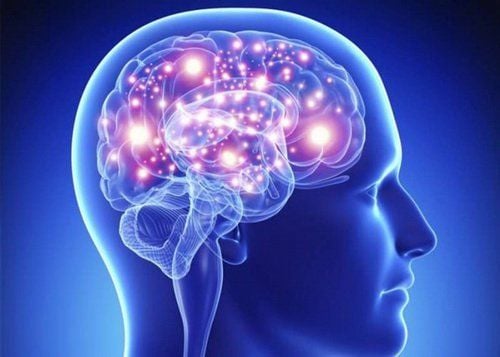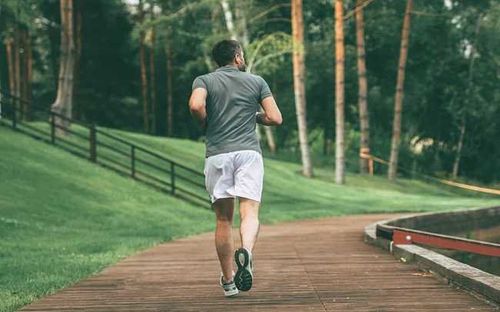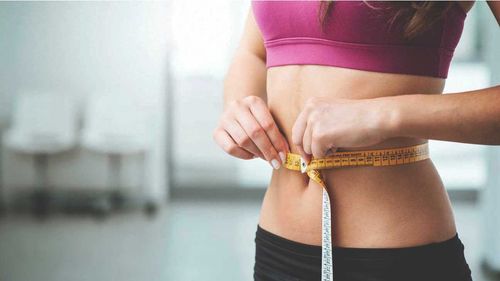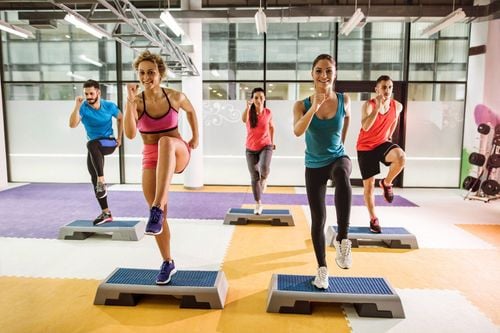This is an automatically translated article.
Aerobic exercise (aerobic exercise) including brisk walking, swimming, jogging, cycling, playing football, ... helps the heart and lungs work hard, increasing the amount of oxygen circulating in the blood. When combined with a low-calorie diet, aerobic exercise results in significant weight loss.
1. 13 benefits of aerobic exercise
Aerobic exercise (aerobic exercise) is activities that help pump blood and stimulate large muscle groups to work. Experts recommend that each person spend at least 150 minutes of moderate aerobic exercise or 75 minutes of vigorous aerobic exercise each week. Moderate activities include brisk walking and swimming. Vigorous activities include jogging and cycling.
The benefits of aerobic exercise include:
1.1 Improves heart health
Aerobic exercise is recommended by the American Heart Association and most doctors for people who have or are at risk for heart disease. That's because aerobic exercise strengthens the heart, helping the heart pump blood around the body more efficiently. In addition, aerobic exercise also helps lower blood pressure, protects arteries by increasing good cholesterol HDL and lowering bad cholesterol LDL in the blood.
If you want to lower blood pressure and cholesterol, each person should choose 40 minutes of moderate or vigorous intensity aerobic exercise, done 3-4 times a week.
1.2 Lowering blood pressure
Aerobic exercise helps control symptoms of high blood pressure. This is a natural way to lower blood pressure without drugs.

1.3 Helps regulate blood sugar
Regular physical activity will help regulate insulin levels and lower blood sugar levels, while keeping body weight at a healthy level. In a study done on patients with type 2 diabetes, researchers found that any form of exercise has the same positive effects.
1.4 Relieve asthma symptoms
Aerobic exercise can help people with asthma reduce the frequency and severity of asthma attacks. However, asthmatics still need to consult their doctor before starting any exercise program. Your doctor can recommend specific activities or precautions to make it safer for you to exercise.
1.5 Chronic pain relief
People with chronic back pain should do aerobic exercise, especially low-impact activities such as swimming or water aerobics to regain muscle function and endurance. In addition, exercise can also help people lose weight - also with the benefit of reducing chronic pain.
1.6 Sleep Support
People who have trouble sleeping at night are advised to try aerobic exercise when they first wake up. Research in people with chronic sleep problems shows that a regular exercise program combined with sleep therapy can effectively help treat insomnia.
People in the study participated in aerobic exercise for 16 weeks and then completed questionnaires about sleep and general mood. The results showed better quality and duration of their sleep, and improvements in alertness and vitality levels throughout the day.
However, exercising too close to bedtime can make it harder for exercisers to fall asleep. Therefore, it is best to complete the exercise at least 2 hours before going to bed.

1.7 Deciding on body weight
Diet and exercise are the foundation for weight loss. Does aerobic exercise lose weight? Aerobic exercise can help with weight loss and maintain this weight loss result.
In one study, scientists asked overweight people to stick to their diets, but participate in extra workouts that could burn 400-600 calories, 5 times a week for 10 days. month. The results show a significant weight loss effect, from 4.3 - 5.7 initial weight. Most of the participants chose to walk or jog on a treadmill. For those who do not use a treadmill, it is possible to walk or jog every day during lunch breaks or before dinner.
Depending on body weight and speed, exercisers may have to walk or jog up to 6.5km to reduce burning 400-600 calories.
1.8 Strengthening the immune system
Researchers tested a group of sedentary and sedentary women to gauge how aerobic exercise was doing to their immune systems.
The results show that regular and moderate aerobic exercise helps increase certain antibodies in the blood, called immunoglobulins, which in turn strengthen the immune system. In the group of sedentary women, there was no improvement in immune system function. At the same time, their cortisol levels were also much higher than in the active group.
1.9 Improve brain power
The brain begins to lose tissue around the age of 30. Scientists have found that aerobic exercise can slow this process and improve cognitive performance.
For the test, 55 elderly people submitted their MRI scans for the researchers to evaluate. The participants were then assessed for their health, including aerobic exercise. The results showed that the fittest adults also had less reductions in the frontal, parietal and temporal brain regions. What it means: Aerobic exercise is good for the body and mind.

1.10 Mood Boost
Exercise also improves mood. In a study of people with depression, they were asked to walk on a treadmill for about 30 minutes per session. After 10 days, they were asked to report any changes in their mood. And as a result, all the participants reported a significant reduction in their depressive symptoms. Thus, exercising even for a short time can have a big impact on mood.
1.11 Reduce the risk of falls
Research shows that every year 1 out of 3 people over the age of 65 have a fall. Falls can lead to broken bones and can result in lifelong disability or disability. Exercise can reduce your risk of falling, and it's never too late to exercise.
Research results from 72 - 87 year old women show that aerobic dancing can reduce the risk of falls by helping the body stay more balanced and agile. The women were asked to exercise for 1 hour, 3 times a week for 12 weeks. The dance sessions included a variety of movements such as squats, foot balance, other basic gross motor tasks, and more. At the end of the study, they were able to perform well on tasks such as closing their eyes and standing. with one foot. They also have better grip and reach than those that help protect the body from falls.
When wanting to exercise, the practitioner should consult a doctor before starting and should start slowly. Classes are a safe choice for exercise. The trainer will help the practitioner know if he or she is doing the right movement, giving suggestions and making appropriate modifications to reduce the risk of injury.
1.12 Safe for everyone, including children
Aerobic exercise is recommended for everyone, including the elderly or people with chronic health conditions. The most important thing is that patients should consult their doctor to choose the right and safe form of exercise for themselves.
Even children should do aerobic exercise regularly. In fact, exercise recommendations for children are slightly higher than for adults. Specifically, children must be active 60 minutes or more each day, moderate activities are best. Children should also participate in vigorous activities at least 3 days a week.
1.13 Low cost and easy access
Aerobic gymnasts do not need to equip expensive equipment or go to high-end gyms to practice. Every day, the practitioner can go for a walk, jog on the street, in the park,...

2. How does aerobic exercise lose weight?
Aerobic exercises for weight loss such as running, fast exercise, swimming, ... help burn more calories than the body consumes. Gradually increasing the duration and intensity of exercise will result in more weight loss. There are many factors that affect the effectiveness of weight loss when doing aerobics. That is:
2.1 Current weight of the practitioner
Current weight can affect the amount of weight lost with aerobic exercise. The heavier the person, the more calories they will burn during exercise. For example, a 84kg person doing low-impact aerobics for an hour will burn about 488 calories. While a 57kg person doing the same will only burn about 330 calories.
This is because weight is the main determinant of the body's metabolic rate. The higher the weight, the more calories burned. In 1 month, assuming excess calories are not consumed, the 84kg person will lose about 1.8kg, while the 57kg person will lose about 1.1kg.
2.2 Types of aerobics
Type of aerobics also affects the number of calories burned and the amount of weight lost. Low-impact aerobics doesn't hurt the joints as much but burns fewer calories than high-impact aerobics activities. Low-impact aerobics are more suitable for people who are older, are obese, or are pregnant.
A 70kg person doing high impact aerobics for 1 hour will burn about 520 calories. While the same person mentioned doing low-impact aerobics, in an hour only burns about 410 calories. Extremely intense aerobic activities like Zumba and spinning can burn up to 800 calories per hour.
2.3 Time and frequency of exercise
The amount of time a person spends doing aerobic exercise also affects calorie burning and weight loss effectiveness. For a person weighing 70kg and doing vigorous aerobic exercise for 30 minutes, 3 times a week, it can be reduced to less than 450g after a month. If that person does vigorous aerobic exercise for 60 minutes, 6 days a week, they can lose more than 1.4kg per month. Remember, to lose 450g a week, a person must burn 500 calories more than they consume in a day.
2.4 Diet
Just trying to lose weight through exercise can burn out or lead to injury. So weight loss can be boosted by adding healthy, low-calorie foods to your diet, while eliminating foods that are higher in calories and lower in nutrients. For example, eliminate bread at dinner and replace it with a spinach salad. At the same time, the practitioner should eliminate desserts and soft drinks, should drink a lot of water to increase the feeling of fullness.
Meals should be mostly lean meats like chicken breast and fish, whole grains, fresh vegetables and fresh fruit. Athletes can also eat small portions of healthy fats like avocado and olive oil, avoiding trans fats and saturated fats.

3. Note when doing aerobic exercise
Before starting an exercise program, the practitioner should consult a doctor. While aerobic exercise is right for everyone, there are some situations that require detailed instructions from your doctor. Specifically:
Aerobic exercise lowers blood sugar. People with diabetes should check their blood sugar before and after exercise. Also, eat a healthy snack before your workout to prevent your blood sugar from dropping too low; People with muscle and joint pain, such as arthritis, should take an extra warm-up time before aerobic exercise. Also, consider taking a warm shower before hitting the gym. Trainers should also equip themselves with well-cushioned training shoes and careful movement control; People with asthma should choose exercises with a shorter duration of activity, such as tennis. That way, the practitioner can rest to let the lungs rest. Also, don't forget to use your inhaler when needed. For those who are new to exercise, feel free to be active. For the first few weeks, you can do 10-20 minutes a day to reduce fatigue and muscle soreness. Later, when the body is used to exercise, it is possible to increase the intensity and duration of the exercise.
Please dial HOTLINE for more information or register for an appointment HERE. Download MyVinmec app to make appointments faster and to manage your bookings easily.
Reference sources: .healthline.com, livestrong.com













